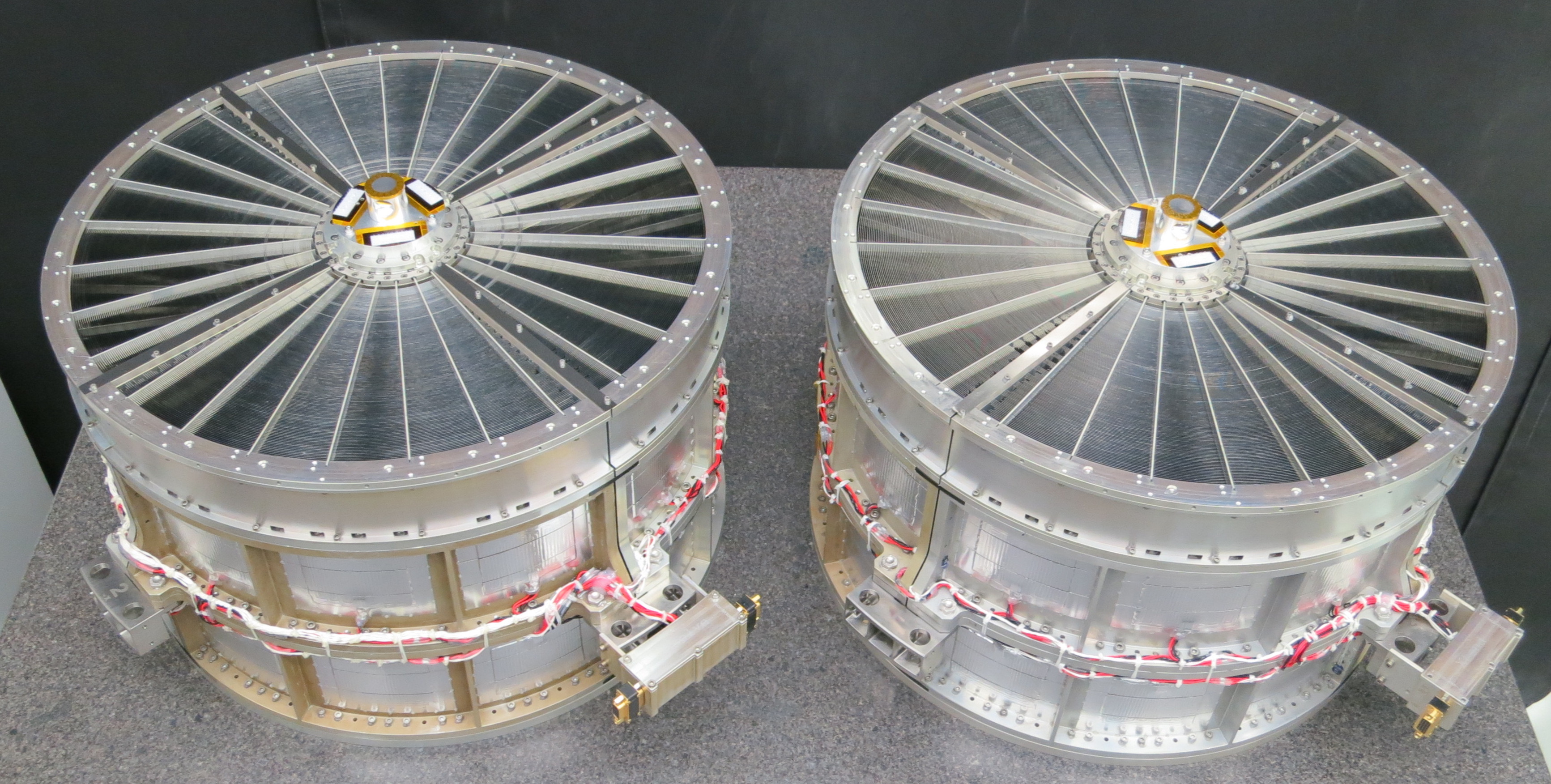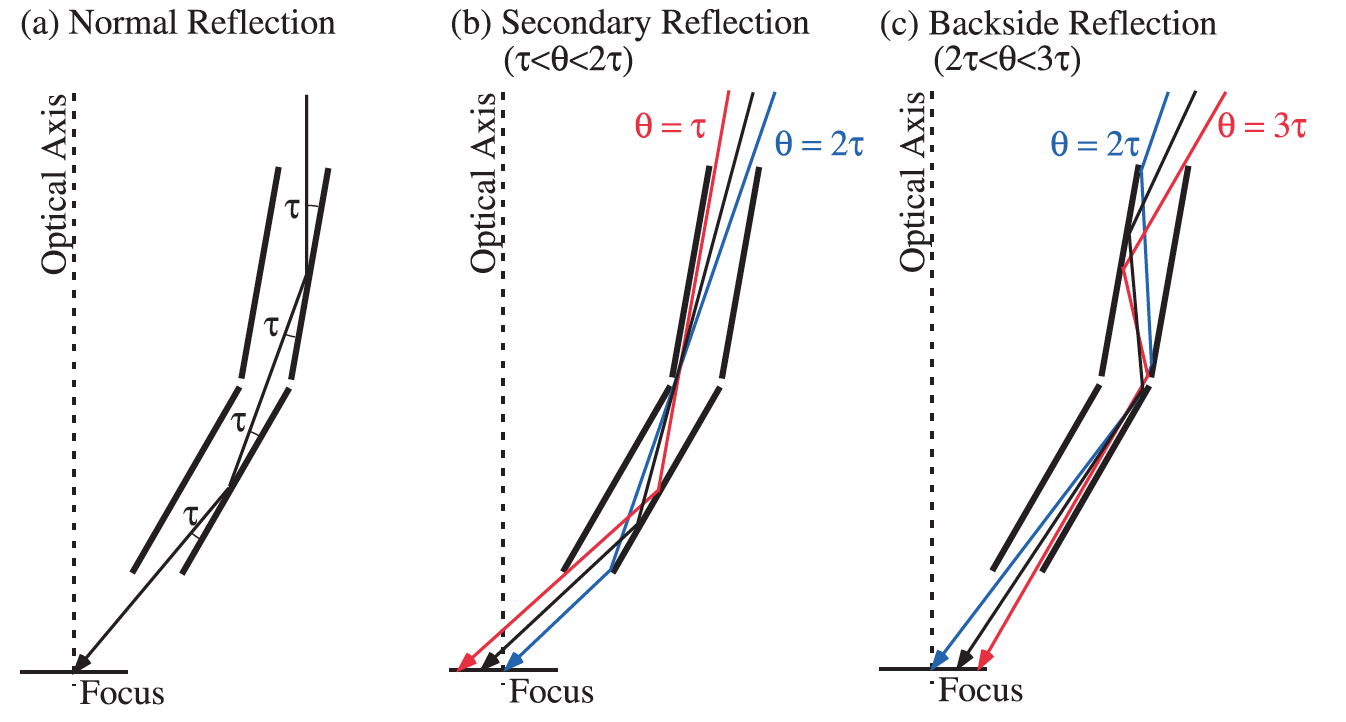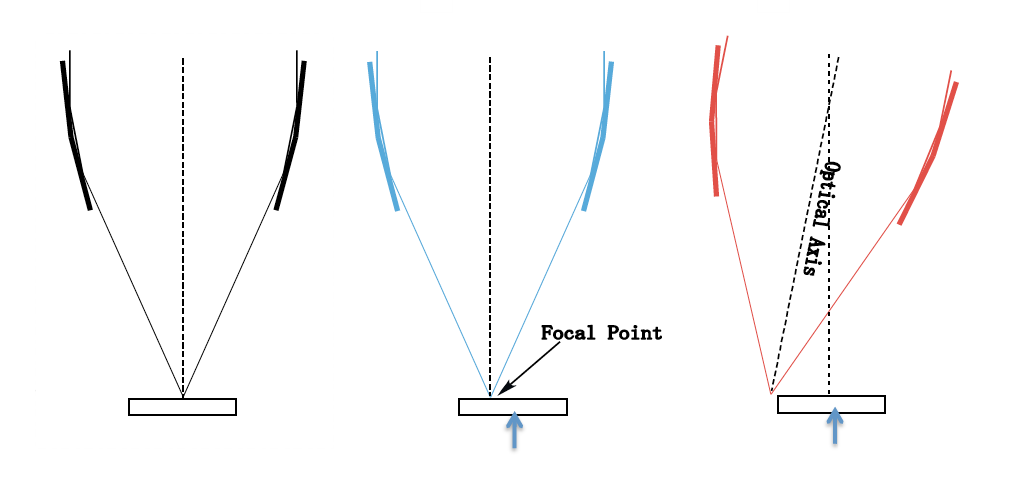Next: 5. Resolve Up: XRISM POG Previous: 3. Observation Policies Contents
XRISM has two X-ray Mirror Assemblies (XMAs) focusing X-rays onto the focal plane detectors. One of these mirrors, Resolve-XMA, focuses X-rays on Resolve, while the other, Xtend-XMA, is used with Xtend. Both mirrors have identical design and improve on the mirrors on-board Suzaku. The entire system (see Figure 4.1) consists of an X-ray mirror, a Pre-Collimator (PC) stray light baffle, and a thermal shield.

|
| XRISM XMA | |
| Focal length | 5.6 m |
| Effective aperture diameter | 12 – 45 cm |
| Height | 20 cm |
| Number of reflectors | 203 |
| Reflecting surface | gold |
| Grazing angle | 0.15 – 0.57 – 0.57 |
Energy range |
0.3 – 15 keV |
Effective Area |
587 cm 1.5 keV 1.5 keV |
438 cm 4.5 keV 4.5 keV |
|
418 cm 6.4 keV 6.4 keV |
|
| Angular Resolution (HPD) | 1.3 for Resolve-XMA and 1.5 for Resolve-XMA and 1.5 for Xtend-XMA for Xtend-XMA |
| Angular Resolution (FWHM) | 8
 for Resolve-XMA and 7 for Resolve-XMA and 7
 for Xtend-XMA for Xtend-XMA |
 The nominal energy range of XMAs is 0.3 – 15 keV. XMAs have sensitivity to higher energy ( The nominal energy range of XMAs is 0.3 – 15 keV. XMAs have sensitivity to higher energy ( keV) photons but the calibration accuracy declines. keV) photons but the calibration accuracy declines.  Includes telescope, pre-collimator, thermal shield but not the detectors. Values are from Boissay-Malaquin et al. (2022). Includes telescope, pre-collimator, thermal shield but not the detectors. Values are from Boissay-Malaquin et al. (2022). |
|
The final result is a relatively light mirror with large throughput over a broad energy range (Serlemitsos et al., 2010, and references therein). Although largely inspired by Suzaku's mirrors, the two XMA mirrors benefited from both relaxed weight constraints and several fabrication improvements, including thicker substrates, a larger number of forming mandrels, thinner epoxy layer for replication, stiffer housings, and higher-precision alignment. All these improvements yield better overall mirror performances, including a smaller angular resolution and an improved effective area both at 1 keV and at 6 keV (Okajima et al., 2012). The XMA was developed at NASA GSFC in collaboration with JAXA/ISAS, and Tokyo Metropolitan University in Japan. The summary of each mirror performance compared when necessary to the relevant requirement is given in Table 4.1. Unless explicitly noted, the parameters mentioned in the table are identical for both mirrors.

|
The grazing-incidence optics adopted for X-ray imagining use a large number (203 in the case of XRISM) of reflectors nested as tightly as possible to increase the effective area. As a result, this configuration increases the possibility of reflection other than the normal double reflection within the telescope. These contaminations of abnormal paths are referred to as “stray light."
Studies on the ASCA stray light (Mori et al., 2005) showed that the main contribution to the stray light is from secondary reflections of photons with an incident angle between  and 2
and 2 (where
(where  is the angle of the primary reflector measured from the optical axis of the telescope – see Figure 4.3).
Therefore, a pre-collimator is installed in order to address the issue of both secondary and backside reflection that would otherwise contaminate data on the focal plane.
is the angle of the primary reflector measured from the optical axis of the telescope – see Figure 4.3).
Therefore, a pre-collimator is installed in order to address the issue of both secondary and backside reflection that would otherwise contaminate data on the focal plane.
The Pre-Collimator (PC) built for XRISM is derived from the one on Suzaku. Each PC consists of cylindrical aluminum shells (blades) with varying radii of 60 – 225 mm, alignment frames to guide the blade positions, and the blade housing body. Each PC blade is placed precisely on top of the respective reflector to reduce off-axis X-ray photons that leads to a “ghost" image within the detector field of view. Since the secondary reflection is caused by the off-axis X-rays going just above the primary mirrors, these cylindrical blades can block this component effectively. The blade thickness is designed to be narrower than that of the reflector. Thus, there is no loss of the on-axis effective area if the alignment between the mirrors and blades is attained. The alignment frame and the housing are made of Aluminum. Heat-forming process is introduced to the production to stabilize the blade shape in orbit. Precise curvature of radius and the linearity along with the direction of incident X-rays ensure that the blades do not obscure the telescope aperture. Figure 4.4 shows a pre-collimator and its geometry and Table 4.2 shows the main characteristics of the XMA pre-collimator.
| Number of segments | 4 |
| Material | Aluminum |
| Number of blades | 204 |
| Number of support bars | 7 |
 7
7  C. This is achieved by covering the entrance side with a thermal shield (TS) composed of the 4 thermal shield quadrants shown in Figure 4.5 for each XMA. These shields isolate the telescopes thermally from space and reflect infrared radiation from the interior of the spacecraft. The thermal shields also work to block optical light coming either from the sky or from the surface of Earth illuminated by the Sun.
C. This is achieved by covering the entrance side with a thermal shield (TS) composed of the 4 thermal shield quadrants shown in Figure 4.5 for each XMA. These shields isolate the telescopes thermally from space and reflect infrared radiation from the interior of the spacecraft. The thermal shields also work to block optical light coming either from the sky or from the surface of Earth illuminated by the Sun.
The shields are made of an aluminized Polyimide
glued to a supporting stainless-steel mesh. The reflectivity in the optical wave band is more than 90%, and yields a rejection of the optical light from the bright Earth and the reflection of the IR radiation from the telescopes at  290 K back to the interior of the satellite.
In addition to the shields,
heaters are affixed to the wall of the housing to keep it within the mandated temperature range.
The whole XMAs are inside the sunshade base.
Thermometers are attached to the wall to monitor the temperature and control the heaters.
290 K back to the interior of the satellite.
In addition to the shields,
heaters are affixed to the wall of the housing to keep it within the mandated temperature range.
The whole XMAs are inside the sunshade base.
Thermometers are attached to the wall to monitor the temperature and control the heaters.
For each mirror, the transmission is maximized when the target is observed along the optical axis. The left diagram of Figure 4.6 shows the “ideal" telescope+detector system. The actual configuration of a mirror includes a shift between the focal point and the detector aimpoint (shown in the middle diagram) and a tilt of the mirror optical axis with respect to the nominal aim-point (shown in the right diagram). Moving off the detector aimpoint from the mirror on-axis focal point results in reducing the effective area due to vignetting. This places the boresight measurement and the determination of the optical axis position as one of the highest priority among the calibration requirements for both instruments. The detector aim point is defined as the center of the Rosolve field of view. The optical axis is tilted about 15" with respect to the nominal aim-point direction, as this angle makes the maximum on-axis effective area. With this small angle, the loss of the effective area is less than 0.5% due to vignetting and is negligible. However, the focal point may shift to +Y direction as indicated in Figure 4.7. Xtend is on-axis at aim point (less than 3" shift). Detailed in-flight calibration is forthcoming. However, the alignment configuration measured at the ground should be adequate for Cycle 1 proposal preparation. Figure 4.7 indicates the location of the detector aim point with respect to the Xtend and Resolve FoVs. The boresight and the pointing accuracy are around 20 arcsec for Resolve and Xtend.

|
![\begin{figure}\begin{center}
\hspace*{-2cm}
\includegraphics[width=0.95\textwidth]{Figure_XMA/XMA_layout.pdf}
\hspace*{-1cm}
\end{center}
\end{figure}](img42.gif) |
The predicted effective area of both the Xtend-XMA and Resolve-XMA can be calculated using ground measurements combined with ray-tracing simulations. Table 4.3 lists the ground measurements for both the Xtend-XMA and Resolve-XMA (Boissay-Malaquin et al., 2022). The simulated effective area curves are plotted in Figure 4.8.
| Energy [keV] | Effective Area (cm ) ) |
|
| Resolve-XMA | Xtend-XMA | |
| 1.5 | 584.7  0.4 0.4 |
589.4  0.4 0.4 |
| 4.5 | 434.7  0.6 0.6 |
441.5  0.6 0.6 |
| 6.4 | 416.0  0.6 0.6 |
422.2  0.6 0.6 |
| 8.0 | 345.3  0.8 0.8 |
349.2  0.8 0.8 |
| 9.4 | 233.4  0.6 0.6 |
235.5  0.6 0.6 |
| 11.0 | 163.4  0.4 0.4 |
164.5  0.4 0.4 |
| 17.5 | 38.4  0.2 0.2 |
37.9  0.1 0.1 |
![\begin{figure}\centering
\includegraphics[width=0.48\textwidth]{Figure_XMA/fig_...
...udegraphics[width=0.48\textwidth]{Figure_XMA/fig_XMA_EAs_log.pdf}
\end{figure}](img43.gif) |
 , see the right panel of Figure 4.9), for Xtend-XMA. The similar curves for Resolve-XMA is shown in Figure 4.10, using a smaller off-axis angle range and 1D Lorentzian model. Figure 4.11 shows these vignetting curves at 6.4 keV for 8 different azimuthal angles for both well fitted with Resolve-XMA and Xtend-XMA, revealing a very similar mirror FoV (defined as FWHM at 6.4 keV of 1D Lorentzian model) of about 14 arcmin for both XMAs.
, see the right panel of Figure 4.9), for Xtend-XMA. The similar curves for Resolve-XMA is shown in Figure 4.10, using a smaller off-axis angle range and 1D Lorentzian model. Figure 4.11 shows these vignetting curves at 6.4 keV for 8 different azimuthal angles for both well fitted with Resolve-XMA and Xtend-XMA, revealing a very similar mirror FoV (defined as FWHM at 6.4 keV of 1D Lorentzian model) of about 14 arcmin for both XMAs.
Figure 4.12 shows the size of XMAs' Field of View (not the detector FoVs), as a function of energy.
![\begin{figure}\centering
\includegraphics[clip, trim=1cm 0cm 2cm 0cm,width=0.6\...
... 2cm 0cm, width=0.39\textwidth]{Figure_XMA/xma_all_direction.pdf}
\end{figure}](img44.gif) |
![\includegraphics[clip, trim=1cm 2cm 2cm 0cm,width=0.68\textwidth]{Figure_XMA/Resolve-XMA-vignetting_energy.pdf}](img45.gif)
|
![\begin{figure}\centering
\includegraphics[clip, trim=2cm 0cm 0cm 0cm,width=0.48...
...0cm 2cm 0cm,width=0.48\textwidth]{Figure_XMA/Xtend-all-rolls.pdf}
\end{figure}](img46.gif) |
![\begin{figure}\centering
\includegraphics[clip, trim=0cm 8cm 0cm 0cm,width=0.7\textwidth]{Figure_XMA/XMAs_FoV.pdf}
\end{figure}](img47.gif) |
The Point-Spread Function (PSF) was measured at nine different energies. Figure 4.13 shows the on-axis focal plane image of the Resolve-XMA and Xtend-XMA, illustrating that the PSF has structures. The PSF structures may have to be taken into account when planning to observe a bright source or analyzing extended sources with a bright point source (Chapters 7 and 8). One-dimensional PSF, which was normalized so that the total number of photons is unity within a radius of 8 , and of the Encircled Energy Function (EEF) for both Xtend-XMA and Resolve-XMA are given in Figure 4.14 and Figure 4.15, respectively. Both figures also exhibit that the profiles are a function of the incoming photon energy.
Table 4.4 summarizes the values of the Half-Power Diameter (HPD) angular resolution. For both mirrors, the measured HPD is found to be better than the 1.7
, and of the Encircled Energy Function (EEF) for both Xtend-XMA and Resolve-XMA are given in Figure 4.14 and Figure 4.15, respectively. Both figures also exhibit that the profiles are a function of the incoming photon energy.
Table 4.4 summarizes the values of the Half-Power Diameter (HPD) angular resolution. For both mirrors, the measured HPD is found to be better than the 1.7 requirement (Tamura et al., 2022).
The typical error of the angular resolution is about 0.01
requirement (Tamura et al., 2022).
The typical error of the angular resolution is about 0.01 in HPD, based on statistical error, uncertainty in the position of the center of the image, and the fluctuation of the CCD background. The angular resolution of the Resolve-XMA is about 0.1
in HPD, based on statistical error, uncertainty in the position of the center of the image, and the fluctuation of the CCD background. The angular resolution of the Resolve-XMA is about 0.1 -0.2
-0.2 better than that of Xtend-XMA at all energies.
better than that of Xtend-XMA at all energies.
| Energy [keV] | 1.49 | 4.50 | 6.40 | 8.05 | 9.44 | 11.07 | 17.48 |
Resolve-XMA [ ] ] |
1.29 | 1.30 | 1.30 | 1.28 | 1.22 | 1.19 | 1.24 |
Xtend-XMA [ ] ] |
1.47 | 1.46 | 1.47 | 1.47 | 1.40 | 1.37 | 1.37 |
![\begin{figure}\centering
\includegraphics[clip, trim=4.5cm 0cm 8.5cm 0.0cm, width=1.2\textwidth]{Figure_XMA/XMA_PSF.pdf}
\end{figure}](img48.gif) |
![\begin{figure}\centering
\includegraphics[clip, trim=1cm 1cm 3.5cm 3cm,width=0.4...
...3.5cm 3cm, width=0.48\textwidth]{Figure_XMA/xma2_psf_all_kai.pdf}
\end{figure}](img49.gif) |
![\begin{figure}\centering
\includegraphics[clip, trim=1cm 1cm 3.5cm 3cm,width=0.4...
...m 1cm 3.5cm 3cm,width=0.48\textwidth]{Figure_XMA/xma2_eef_kai.pdf}\end{figure}](img50.gif) |
Stray light designates X-rays that enter the detector via a path other than the normal
double reflections. It includes the case of a single reflection on either
reflector, a reflection on the back side of the reflectors, or a reflection
on the pre-collimator blade. The pre-collimator significantly reduces the amount of
stray light (as seen in 4.1.2), but it also causes slight stray light.
Stray light that can occur in a multi-nested thin foil optic was discussed
in detail by Mori et al. (2005). Figure 4.16 shows the stray light images
at 1.49 keV obtained at 30 and 60
and 60 off-axis angles at an azimuthal angle. In both images, the X-ray source is positioned on the right side. This is the same stray light
structure reported for the Hitomi SXT mirrors (Iizuka et al., 2018).
The 30
off-axis angles at an azimuthal angle. In both images, the X-ray source is positioned on the right side. This is the same stray light
structure reported for the Hitomi SXT mirrors (Iizuka et al., 2018).
The 30 off-axis image has a component biased to the right side of the
image, while in the 60
off-axis image has a component biased to the right side of the
image, while in the 60 off-axis image there is stray light spread over the
entire detector. The stray light seen on the right side of the 30
off-axis image there is stray light spread over the
entire detector. The stray light seen on the right side of the 30 off-axis images is due to the reflection of the pre-collimator, while the extended component is mainly due to the reflection on the backs of the reflectors. We note that the direct component coming through the gap between the inner wall of the housing and the innermost reflector reported for Hitomi SXT Mirror (Iizuka et al., 2018) is not seen in XMAs, because bare aluminum foil was added inside the innermost reflector to removes the direct incident component (Tamura et al., 2022).
The main contributions on the measured stray light for XMAs are probably due to pre-collimator reflections. The amount of stray light entering within an 8
off-axis images is due to the reflection of the pre-collimator, while the extended component is mainly due to the reflection on the backs of the reflectors. We note that the direct component coming through the gap between the inner wall of the housing and the innermost reflector reported for Hitomi SXT Mirror (Iizuka et al., 2018) is not seen in XMAs, because bare aluminum foil was added inside the innermost reflector to removes the direct incident component (Tamura et al., 2022).
The main contributions on the measured stray light for XMAs are probably due to pre-collimator reflections. The amount of stray light entering within an 8 radius, converted to effective area, is shown in Table 4.5 as well as the amount of stray light entering the Resolve detector. We note that the flux of the stray depends on the azimuthal direction of the incident photons, and the values in Table 4.5 are instances.
The detailed analysis of stray light will be performed with the in-flight calibration data. However, expected stray light effects will not be large based on Suzaku observations. Therefore, proposers are not expected to consider stray light contamination on their targets when planning proposal submissions.
radius, converted to effective area, is shown in Table 4.5 as well as the amount of stray light entering the Resolve detector. We note that the flux of the stray depends on the azimuthal direction of the incident photons, and the values in Table 4.5 are instances.
The detailed analysis of stray light will be performed with the in-flight calibration data. However, expected stray light effects will not be large based on Suzaku observations. Therefore, proposers are not expected to consider stray light contamination on their targets when planning proposal submissions.
Resolve-XMA (r 8 8 ) ) |
Resolve-XMA (Reslove FoV) | Xtend-XMA (r 8 8 ) ) |
|
30 off-axis [cm off-axis [cm ] ] |
0.26  0.01 0.01 |
0.007  0.001 0.001 |
0.16  0.01 0.01 |
60 off-axis [cm off-axis [cm ] ] |
0.18  0.01 0.01 |
0.009  0.001 0.001 |
0.11  0.01 0.01 |
![\begin{figure}\centering
\includegraphics[width=0.4\textwidth]{Figure_XMA/reslv...
...includegraphics[width=0.4\textwidth]{Figure_XMA/xtend_m60_cb.png}\end{figure}](img52.gif) |